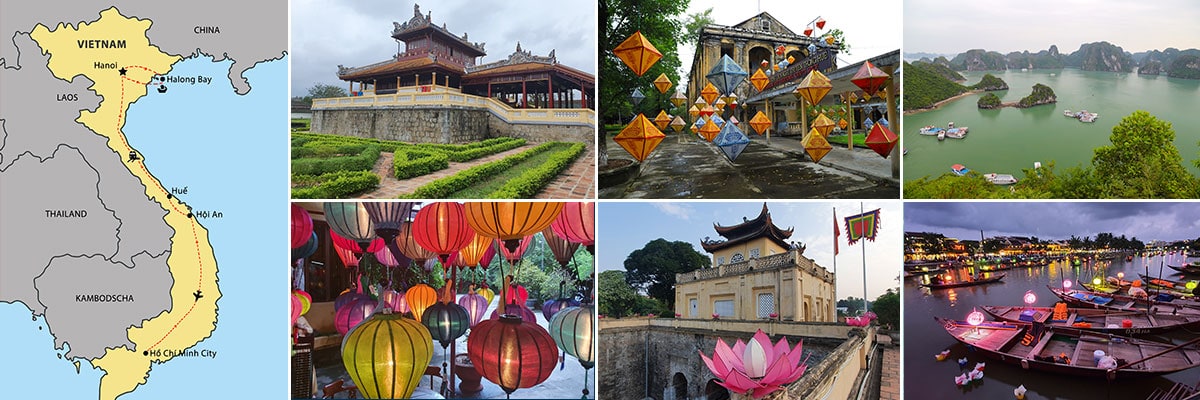After visiting the impressive imperial citadel of Hue in the morning, we had an optional excursion to the tomb of Emperor Minh Mang and the Thien Mu pagoda in the afternoon.

Table of contents
The Tomb of Minh Mang
Around 2 p.m. we drove by coach from our hotel in Hue to the tomb of Minh Mang, 12 kilometers away. As soon as we arrived at the parking lot of the site, it started to rain heavily and unfortunately did not stop. What a pity!
Emperor Minh Mang (1791-1841) was the second emperor of the Vietnamese Nguyen dynasty, who served from 1820 until his death. Its tomb is located on the west bank of the Perfume River, has an area of 15 hectares and is surrounded by a 2 km long wall.
The site includes about 40 temples, pavilions and gates, all located on a main axis in the middle of Lake Trung Minh. At the end of this straight main axis is the burial mound on which the emperor is buried. This area is usually not accessible to visitors – however, once a year, on the anniversary of the emperor’s death, the gates to the tomb are opened.
A dragon boat ride on the Perfume River
After looking at the burial site together with our Gebeco tour guide for about an hour in continuous rain, we walked from the plant down to the perfume river. Here a so-called dragon boat was already waiting for us: the top of the boat is made of metal and shaped like a dragon’s head – with eyes, pointed white teeth and a red tongue. The hull of the ship is painted with dragon scales.
In the covered main room of the boat, red plastic chairs were provided for us; on two tables, souvenirs were already designed for sale. Looking into the back of the boat, we quickly realized that the family who are sailing around the perfume river, also live on the boat.
With (an almost too) leisurely pace we drove along the perfume river for an hour, which was actually a bit boring, because there was nothing spectacular to see on the shore and moreover the weather was very bad.
The Thien Mu Pagoda
Around 5 p.m. we arrived at the Thien Mu-Pagoda which is located on a hill on the northern bank of the Perfume River. With its 21-metre-high, seven-storey tower, it is considered the tallest pagoda in Vietnam. The pagoda was built in 1601 in a simple construction. In 1665 the buildings were renovated and extended. One of the special sights of the Thien Mu Pagoda is the large bronze bell from 1710, which was made with its almost 2 kilograms especially for the temple.
Behind the high wall of the pagoda is the Buddhist monastery complex with several halls and a garden with bonsai trees. In an outbuilding, a small car commemorates the most famous monk of the monastery and his sad history. Tich Quang Duc drove his car to Saigon in 1963 to set himself on fire in protest against the oppression of Buddhists on the open road. The car and a press photo that caused a worldwide sensation are intended to commemorate the victims in the struggle for religious freedom in Vietnam.
After a 30-minute stay we went back to Hue at dusk. Forty minutes later we arrived in Hue in complete darkness, were picked up by our bus on the shore and driven to the hotel. In the evening we ate something near the hotel and then we fell into bed tired and with many new impressions.
All travelogues from Vietnam
During our 10-day trip with Gebeco through Vietnam we got to know many different sides of the country. Starting with the pulsating capital Hanoi and the millions of scooters on the streets, the majestic beauty of Halong Bay, an exciting night train ride to the cultural centre of Hue, further to the old town of Hoi An, which is a UNESCO World Heritage Site, and on to the megacity of Saigon in the south of the country. Our trip was very varied and full of contrasts and here you can find an overview of all travel reports: » Day 1: Our trip “Typical Vietnam!” with Gebeco (Vietnam)
» Day 1: Our trip “Typical Vietnam!” with Gebeco (Vietnam)» Day 2: Hanoi – Tourist Attractions, Things to Do & Photo spots (Vietnam)
» Day 3: Halong Bay – A day trip from Hanoi (Vietnam)
» Day 3: The Night Train from Hanoi to Hue (Vietnam)
» Day 4: Hue – Citadel & Imperial Palace with the Forbidden City (Vietnam)
» Day 4: Hue – Emperor’s Tomb of Minh Mang & Thien Mu Pagoda (Vietnam)
» Day 5: From Hue to Hoi An – The Cloud Pass & Da Nang (Vietnam)
» Day 5: Hoi An – Tourist Attractions, Things to Do & Photo spots (Vietnam)
» Day 6: My Son – The ruins of the ancient temple city at Hoi An (Vietnam)
» Day 7: Saigon – Die Sehenswürdigkeiten von Ho Chi Minh Stadt
» Day 7: Saigon – A culinary Vespa tour of the city (Vietnam)
» Day 8: The Mekong Delta – A bike & boat tour (Vietnam)
» Day 9: Cu Chi – The Tunnels of the Vietcong in the Vietnam War (Vietnam)
